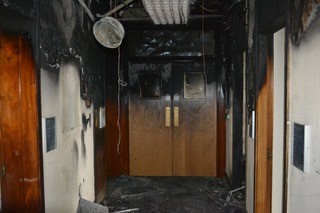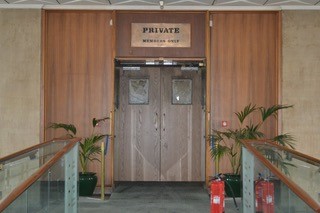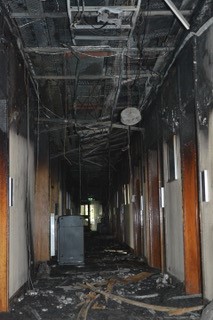A Simple Guide to Fire Doors
- Dean Bird
- Jul 14, 2024
- 4 min read
Updated: Aug 3, 2024
Fire Doors come in all shapes and sizes. They should have signage which identifies them e.g. Fire Door Keep Closed and other subtle differences which set them apart from non fire doors. In older premises they may be harder to identify. These are known as either “notional” or “nominal” doors .
A 'notional' fire door, according to advice by the UK government, is a fire door that satisfied the standard applicable to fire-resisting doors at the time of the building's construction. This type of door may not have been fitted with intumescent strips and smoke seals. Nominal fire doors are doors that have no evidence of certification and thus no indication of fire separation performance, but in the opinion of an assessor, is still suitable enough to hold back a fire and act as a fire door.
So, In short, although we are aiming for fully certificated modern doors in most older buildings inspectors may have to make a value judgement on the door. New fire door sets are costly and therefore consideration should be given to improving the existing doors to improve safety if the costs for new doors are prohibitive. This should be judged alongside the Fire Risk Assessment.
London Fire Block Ltd specialise in the upgrading and improvement of existing doors in an effort to improve their performance in fire. Various upgrades and improvements can be made, however, an upgraded door is no match for a modern fire door. They are tested to high standards under controlled fire conditions.
Features of fire doors
Here are some of the key features to look out for in terms of both domestic and commercial use:
Fire doors are made up of various components. The door itself is usually made from a solid timber frame, but they can sometimes be covered again in fire-resistant glass. This glass should be able to withstand exposure to the heat condition in a fire test for at least 60 minutes before it reaches a temperature high enough to soften it.
Around the edges of the door will be the intumescent seal or intumescent strip. An intumescent seal is chemically designed to expand when temperatures reach beyond 200°C to seal the gaps between the door and frame. These seals (or strips) usually come with either 30 or 60 minute ratings.
For a private premises, it is advised to install fire doors where the risk is most imminent, for example the kitchen, or rooms which house lots of electrical devices. If your property is a new build, it should have been subject to regulations ensuring certain doors are fire doors – check this with the developer. As it currently stands, fire doors are only legally required in Houses in Multiple Occupation (HMOs).
For commercial or non-domestic properties, liability lies with whoever is deemed the ‘responsible person’ for that property or the employer. For example, the owner of the property, or the person in control of the property for trade reasons would be responsible.
Thorough risk assessments must be carried out and it is advisable to get professional help with all fire-safety-related regulations. There is more to passive fire protection and fire safety than just fire doors; escape routes, lighting, warning systems and equipment checks are also required.
When you’re choosing a door it’s important to know what the different specifications mean. The FD code shows how many minutes of fire a door can withstand, for example an FD30 has been tested to withstand 30 minutes. The most common two codes are generally considered to be FD30 and FD60. The test procedures manufacturers use are specified in BS 476-22:1987 or BS EN 1634-1:2014.
Many deaths during fires are not from direct contact with the flames, but the consumption of smoke. With this in mind, keep an eye out for a doorset with cold smoke seals. These should be within the intumescent seal. Exceptions may apply where the leakage of the smoke is essential for detecting a fire early.

This photo clearly shows a smoke blackened area in the main office and, beyond the fire doors, clean undamaged walls. This clearly shows the effectiveness of a properly fitted door.
Fire doors which are inappropriately used or incorrectly fitted are common fire safety issues. Below we have compiled a list of common mistakes in fire door usage.
Common fire door issues:
Doors wedged open, allowing potential smoke and fire to spread
Door jamming on the frame
Self-closing device failing to shut the door and needing adjustment
Strips and seals around door becoming damaged or ineffective
Damage to the door front or edge, affecting the door’s fitting
Glazing becoming loose due to damage
Glazing being replaced by glass which is not fire resistant
Poorly fitted doors, perhaps fitted by someone unqualified
Use of inappropriate materials, such as non-fire resistant wood
Doors fitted in walls or next to glazing that isn’t fire resistant
For more information about door fire safety call us for a free consultation
In these series of picture it shows how the combination of working fire doors and thorough fire stopping kept the fire confined to one corridor. The doors actuated on a self closer and effective maintenance ensure that the doors were perfectly aligned to allow the intumescent seals to perform as designed.
In Image 1, you can see how the heat has risen to the top of doors and this is the area that endures the most stress. The false ceiling has been completely destroyed. Compliant fire stopping has protected the compartment and stopped the spread.
This (Image 2) is the other side of the door. There can be no better advert for a fully functioning door.
Image 3 shows the severity of the fire and, although the damage is severe, it is completely salvageable. You can clearly see how this fire had potential to spread throughout the building causing a complete loss.
London Fire Block Ltd is one of the UK’s leading fire stopping companies. With 35 years of experience, our experts are able to accurately assess fire risk in your buildings and install measures to ensure full compliance with current regulations. If you’d like to know more, get in touch with London Fire Block Ltd today.
Disclaimer: This post is intended for educational use only, and should not be relied upon for compliance purposes.









Comments